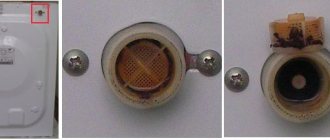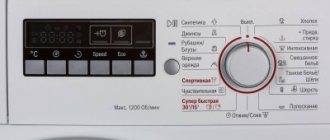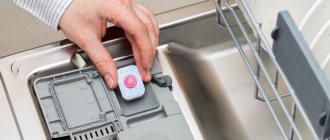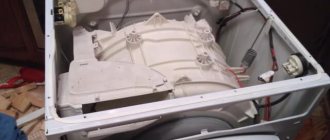Washing dishes in a machine is very convenient, but it cannot be said that this technique is without its drawbacks. The quality of processing may decrease immediately after installing the device or after some time. The most unpleasant problem for housewives is the white residue in the dishwasher that settles on the surface of the dishes. How to fix it?
You will learn everything about the reasons for the appearance of mineral deposits inside the dishwasher from the article we presented. We will tell you how to prevent formation and how to clean it off if it has managed to settle. We will tell you what rules to follow during the operation of the equipment, ensuring the extension of its working life.
Irregular care
The cleanliness of equipment significantly affects the quality of work and can even cause breakdowns. All dishwasher owners need to remember a simple rule: “a clean dishwasher means perfectly washed dishes.”
Properly working equipment suddenly stopped coping with its task even during long intensive cycles. The result is poorly washed plates and cutlery with stains. Sediment and white residue are also found in the dishwasher itself when inspecting the internal compartment. This happens if preventive cleaning has not been carried out during the entire period of operation.
During prolonged use without cleaning the internal drains and spray nozzles, limescale, food particles and grease can accumulate on the surface and clog the filters. Due to deposits, the nozzle holes become smaller in size and cannot discharge water in the required volume. This results in poor cleaning and white residue on the dishes.
Often this problem is solved on your own by cleaning all dirty filters and removing deposits manually or using a cleaning program. Carefully inspect the filters inside the dishwasher; they may need to be removed and washed under running water with a grease remover. Limescale can also be removed manually using a soft sponge and a small amount of limescale remover.
Most dishwashers have a cleaning program for removing plaque and grease. You can use special products or regular citric acid. It is poured into the detergent powder compartment, then a cleaning program or simply an intensive mode at high temperatures is set.
Quality and dosage of detergents
If everything is in order with the internal elements - they are clean and there are no traces of scale, then the reason should be looked for elsewhere.
One of the most common reasons why a white residue remains in the dishwasher is an error in the dosage and selection of special household chemicals for washing dishes.
When using multi-component capsules on short washing cycles, it happens that they simply do not have time to dissolve completely, and the remaining product settles on the surface of the dishes and causes white stains to appear. Another option is low-quality chemistry.
Advice! If, after using new capsules, a problem with a white coating appears, try changing the product and stop using the previous one. Most likely, it is not suitable for your equipment.
Perhaps the reason is simpler than it seems. The product has been added incorrectly to the compartment (there may be too much of it, the lid is not tightly closed, so the product can get into the chamber with the dishes), the compartments for powder and rinse aid are mixed up. As a result, a white coating appears after the end of the cycle and the dishes are not washed properly.
To solve the problem, carefully study the operating instructions for your PMM, which indicates the recommended amount of chemicals and which compartments are intended for a particular type. Be sure to fill according to manufacturer's specifications and seal lids tightly.
Try to choose proven brands of “3 in 1” capsules, do not use them for short programs. Only by trial and error can you find your ideal remedy.
Advice! Do not resort to using liquids for manual dishwashing or traditional methods such as vinegar and soda; such experiments usually end in expensive equipment repairs.
Quality and dosage of rinse aid
Incorrect dosage or inadequate quality of this chemistry can affect the washing result. As a result, stains on cutlery and dishes.
A full cycle dishwasher uses three chemical components to achieve perfect cleanliness and shine of dishes: powder, rinse aid and regenerating salt. If you use each product separately, and not complex capsules, then the presence of rainbow stains or a white coating on the dishes (especially noticeable on transparent ones) indicates that something is wrong with the rinse aid.
It often happens that a housewife, busy with household chores, mistakenly pours rinse aid into the compartment, for example, for powder. As a result, the product is used from the very beginning of the cycle and is poorly washed off the walls of glasses and plates.
If the compartment lid is not closed tightly enough, rinse aid may leak into the compartment itself and leave stains. The same situation occurs if the product is poured in excess.
Concentrated rinse aid must be used in smaller quantities than regular rinse aid. Try checking the dosages in the dishwasher instructions and on the air conditioner label.
Cheap or new chemistry may not be suitable specifically for your case. If you recently changed the brand of rinse aid, there is a high probability that stains on the dishes were caused by it.
Reasons for the formation of plaque on dishes
White flakes and stains in the dishwasher are limescale. In a centralized water supply, the water is hard and contains impurities of salts such as calcium, magnesium, etc. Owners of an autonomous water supply system are not immune from this problem, especially if water is drawn from cracks in limestone rocks.
When heated, these substances transform into a white precipitate called scale. This is the most common cause of whitish spots on washed dishes.
A plaque of similar composition forms inside the kettle. To improve the situation, manufacturers have included a special module in the design of dishwashers - an ion exchange system.
This is a container filled with a resinous filler, into which regenerating salt is added. When the water entering the machine passes through an ion exchanger, chloride ions neutralize metal salts and soften the water.
The presence of impurities that affect the hardness parameters of tap water can be determined visually. If water poured into a transparent vessel has a “rusty” tint, it means that it has undergone poor-quality filtration. Consequently, excess calcium and magnesium from the water is also not removed
The lack of salt or its insufficient amount leads to the appearance of plaque. But the reasons for the lack of this remedy need to be understood.
The appearance of plaque may indicate that the settings have gone wrong, the salt has simply run out, that this particular product is not suitable for local water, etc. But it also happens that plaque becomes a sign of serious damage.
If the hardness control is not set correctly, insufficient salt will flow into the machine. Manufacturers often equip the device with test strips, which allow you to correctly determine the level of hardness in order to set the necessary settings.
The white coating that appears on the surface of dishes after washing is scale, limescale deposits that form when hard water is heated.
If you don’t have such strips, you can ask your local water utility for help, order a water test from a well, or simply buy a set of such strips. If the quality of dishwashing is unsatisfactory, you need to correct the situation immediately. Otherwise, it will only get worse, and you will have to call a specialist and pay for expensive repairs.
Hard water
A similar reason for the appearance of white limescale is too hard water. For high-quality washing of dishes, you need water of sufficient softness, which can be achieved using a special system with regenerating salt. Before the first start, you need to adjust the hardness parameters using test strips, set the value, and fill the compartment with salt. But if the dishwasher leaves a white residue, the parameters may have gone wrong or there are some problems with salt intake.
Incorrect settings or incorrect settings can identify the degree of water hardness incorrectly, thereby softening it insufficiently. There is another reason: the salt has run out or has completely entered the washing compartment through a loosely closed container lid.
In different regions, the degree of water hardness is different, even in city areas it may differ. For proper operation of the dishwasher, it is important to know the exact value of this parameter in your water supply network. Typically, manufacturers include special test strips in the kit, with which you can obtain the value and correctly configure the PMM. Check if the parameters match; it happens that due to incorrect settings, the machine does not soften the water enough.
You also need to monitor the amount of regenerating salt. Its absence provokes plaque on the internal elements of the PMM and utensils. It is important that the product does not fall into the compartment with the dishes, but is in a special container with a tightly closed lid.
Attention! There should always be salt in the dishwasher! If you just filled it in, you can run the equipment “idle” on any program immediately before loading the dishes.
Technical problems and violation of operating rules
Careless handling or use of the dishwasher for other purposes will inevitably lead to problems and subsequent failure. But the likelihood of white marks appearing on dishes due to a simple breakdown of some element is also high. Let's look at the most common reasons.
Damage to the water hardness sensor
In premium class dishwashers, the manufacturer installs a water hardness sensor. This function is very convenient: the equipment itself determines the quality of the incoming liquid and consumes the right amount of salt automatically. If after each use of the dishwasher you notice white marks on the walls of the dishes, this may be a sign of a breakdown of this device.
The sensor monitors the consumption of regenerating salt. In the event of a breakdown of this element, salt is taken in a smaller quantity than necessary. Scale, which results from heating hard water, settles on the walls and dishes, causing white spots and stains.
Unfortunately, it is difficult to fix this breakdown on your own. A service center or a competent technician will be able to replace the sensor with a new one.
Failure of the ion exchanger
An ion exchanger is a container with resin that allows you to remove magnesium and calcium ions from the incoming water flow at the molecular level. The result is that the water becomes softer, and scale and white deposits do not appear in the dishwasher. In order for the system to work properly, a special regenerating salt is needed, which is poured into the compartment and allows the resin to be used in the ion exchanger again.
Such an important unit rarely breaks, but if a white residue remains on the dishes, and you are confident in the quality of the chemicals used and the cleanliness of the internal elements, then perhaps the ion exchanger is faulty.
Low pressure in pipes
Try washing dishes with your hands under a thin stream of water! You'll spend more time than usual, and detergent residue will be harder to remove from dishes and glassware. As a result, they are covered in streaks and a white soapy coating.
Now imagine that instead of the required pressure, a thin stream of water is supplied to the dishwasher. In this case, you should not expect high-quality washing.
Start the equipment and watch how it takes in water. Longer than usual? You can find out the quality of the pressure by simply unscrewing the tap all the way. If the water supply is poor, then the problem of why the dishwasher leaves white spots on the dishes lies precisely in this.
In private homes, you can solve the problem by installing a water pump, but if your house is connected to a central network, you will have to wait for the problem to be resolved (perhaps they are troubleshooting the line) or deal with the supplier.
How to solve problems with a new dishwasher
Repair activities should not be started without checking the warranty periods for the dishwasher. Most often, the manufacturer provides a 1-year warranty, but responsible companies extend the period of free repair or replacement to 5 years.
If the machine breaks down during the first year of operation, it is not recommended to disassemble or replace spare parts on your own. You should immediately contact the store where you purchased the dishwasher and clarify the repair rules.
Approximate procedure:
- submitting an application for warranty repair - the store or service center must provide a special form or fill it out yourself;
- choosing a convenient time to remove equipment;
- drawing up a transfer act at the time of export;
- if desired, submit an application for the issuance of replacement goods.
The last point is spelled out in the law “On the Protection of Consumer Rights” (Article 20). The application is handed over to the store representatives against signature, the original is kept by the buyer. Instead of broken equipment, they issue a new one of the same class for the entire repair period.
But you shouldn’t always rush to hand over your equipment for repair. To ensure that seemingly correct actions do not turn out to be an incident, you should first check whether the machine is connected correctly. So, the dishwasher may not work because you forgot to plug the plug into the socket or open the water supply tap.
If you installed and connected the dishwasher yourself, it would be a good idea to check whether everything was connected correctly. We presented the main nuances of self-connection in the following article.
It is necessary to check whether the wiring is working properly and whether the circuit breaker in the apartment electrical panel is turned on. You can check the current supply to the outlet using another electrical appliance.
If all connection steps have been completed correctly, but the new machine does not perform the task or works intermittently, we recommend using warranty service.
Sources
- Shurukhnov, N.G. Constitutional law of the Russian Federation in schemes / N.G. Shurukhnov, V.V. Mechikov. - M.: Eksmo, 2010. - 240 p.
- Veniamin, Nikolaevich Vylegzhanin How to sell / buy an apartment correctly: a reminder for the seller and buyer of real estate / Veniamin Nikolaevich Vylegzhanin. - M.: Prospekt, 1985. - 601 p.
- Law and Economics No. 08/2010; Justitsinform - M., 2010. - 839 p.
- Social security law in Russia; Prospect - M., 2003. - 902 p.
- Ablezgova, Olesya International private law. Answers to exam questions / Olesya Ablezgova. - M.: Scientific book, 2009. - 513 p.
Prevention measures
The best solution to the problem of plaque is prevention. In order to ensure that the quality of the washed dishes, as well as the operation of kitchen appliances, is enjoyable, it is important to follow simple rules:
- monitor the cleanliness and technical condition of the dishwasher;
- before starting the PMM, load chemicals in precise dosages into the appropriate compartments;
- use high-quality, proven products;
- correctly arrange dishes in the dishwasher and do not load them more than the permissible amount;
- choose a program depending on the type of pollution;
- Before loading into the PMM, always clean the dishes from food residues, since clogged filters impair the outflow of water, which affects the quality of washing.
Principle of operation
Of course, before we do the repairs ourselves, we will need instructions. If we talk about the principle of operation in general, then it is worth knowing that each machine has several standard modes with a similar algorithm - and the sequence of operations (as well as the principle of execution) will not differ significantly depending on the model.
The instructions describe the following operations:
- The machine draws water from the central network through a salt softener.
- The water flow enters under pressure through the filter and is regulated by a special float valve.
- When the machine has collected enough water, the supply is shut off and heating starts.
- After heating, water is pumped into the working chamber and sprayed through the upper and lower elements.
- The waste water is purified in a 2-stage filtration system, after which it is used again for washing.
- During the washing process, a special powder must be added.
- The water is used “in a circle” several times and only at the very end the machine drains it. Drainage is also provided by a special pump.
- When the washing process is completed, drying is carried out - it can be condensation or turbo. In the latter case, the process goes faster, since a fan is used for drying.
In short, the whole process looks like this: water intake, preliminary and main washing, draining, drying.
Advice! If the instruction manual is lost, download it from the manufacturer’s website or any large equipment store.











